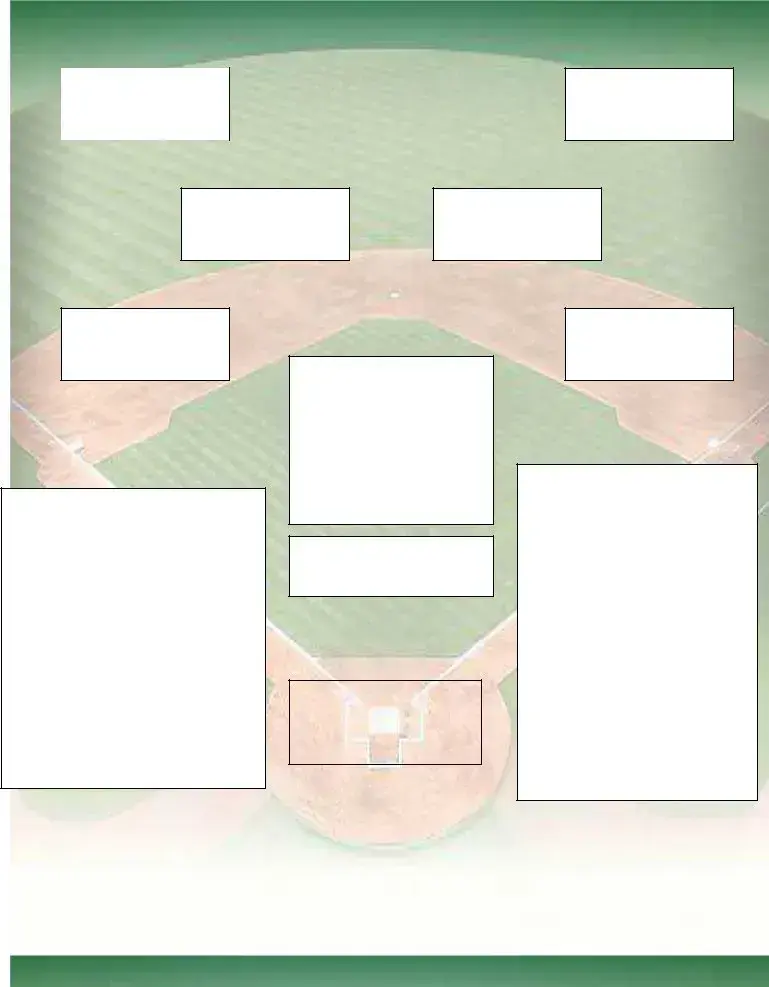The Baseball Field Lineup form shares similarities with the Player Roster form. Both documents are essential for organizing team members and ensuring that all players are accounted for during a game. The Player Roster form typically includes player names, positions, and jersey numbers, much like the lineup form, which lists players in a specific batting order and depth chart. This helps coaches and managers make informed decisions about player placement and substitutions during the game.
Another document akin to the Baseball Field Lineup form is the Game Day Checklist. This checklist outlines all necessary preparations for a game, including equipment checks, player availability, and logistical arrangements. Similar to the lineup form, the Game Day Checklist helps ensure that everything is in order before the game begins, allowing coaches to focus on strategy and player performance rather than administrative tasks.
The Pitching Rotation form is also comparable to the Baseball Field Lineup form. It specifically details the order in which pitchers will be used throughout a series of games. Like the lineup form, it includes sections for starting pitchers and relief options, helping coaches manage their pitching staff effectively. This ensures that pitchers are utilized optimally based on their strengths and the opposing team's weaknesses.
Another related document is the Team Strategy Plan. This plan outlines the team's approach to a specific game, including offensive and defensive strategies. While the Baseball Field Lineup form lists players and their positions, the Team Strategy Plan focuses on how those players will work together to achieve victory. Both documents are crucial for preparing a team for competition.
The Scouting Report is another document that complements the Baseball Field Lineup form. This report provides insights into the opposing team's strengths and weaknesses. Coaches use it alongside the lineup form to make strategic decisions about player matchups and game tactics. By analyzing the scouting report, teams can adjust their lineup to exploit weaknesses in the opponent's performance.
The Game Summary form is similar in that it captures the results and key events of a game. After the game, coaches can refer back to the Baseball Field Lineup form to assess how the lineup performed and what adjustments may be needed for future games. This form serves as a record of player performance and can influence decisions for upcoming matchups.
Additionally, the Injury Report is related to the Baseball Field Lineup form. This document tracks player injuries and their availability for games. Coaches often refer to both forms to determine which players can participate and how to adjust the lineup accordingly. Understanding player health is essential for maintaining a competitive edge throughout the season.
The Scorebook is another document that bears resemblance to the Baseball Field Lineup form. It records the details of the game as it unfolds, including player statistics, runs scored, and other key metrics. While the lineup form focuses on pre-game organization, the Scorebook captures the live action, allowing teams to analyze performance after the game and make necessary adjustments in future lineups.
Lastly, the Practice Schedule is similar in that it outlines the training plans for the team. Like the Baseball Field Lineup form, it helps coaches organize player participation and focus on specific skills or strategies. Both documents are vital for team development and ensuring that players are prepared for game day.

